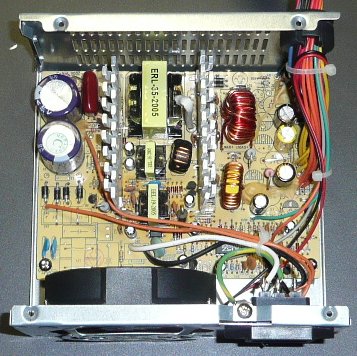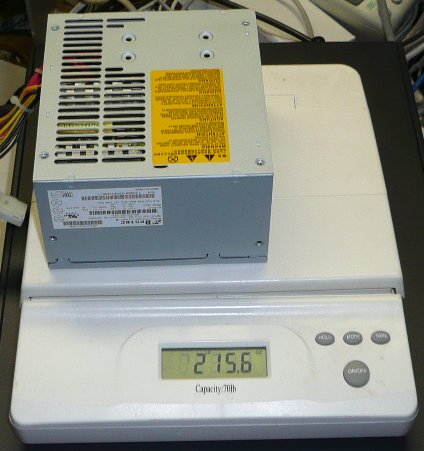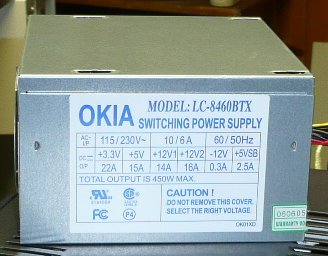A
Word About Power Supplies
This story all started
with an eBay
purchase, consisting of an eMachines personal computer. A customer of
mine lost their computer when a severe power disturbance took place,
and the resulting power
supply failure also killed the motherboard.
They wanted to try a
direct
replacement first, so I found and purchased what seemed like the
perfect thing--an exact replacement system from what seemed like a
reputable seller. It even arrived well packaged, so I was surprised
when it did not work.
I was a little less
surprised when I
saw that the original Bestec power supply was gone, replaced by a 450
watt "OKIA" power supply. Clearly something had gone wrong, although
the reason behind the replacement was unclear, especially since the
seller billed the system as working. I later discovered the motherboard
was not the same as the customer's system...the original had an Intel
845 board while the eBay system had an Intel 865.
So I'm not sure what
happened. I
suspect the original 845 board in the eBay system died when its power
supply failed. If there was a replacement board, it is hard to say how
it failed.
What that left me with
was a
perfectly serviceable case and seemingly good power supply that spent a
few months sitting around doing nothing. I found a deeply discounted
triple core AMD Phenom CPU and an Asus motherboard, and they went into
this case. Everything seemed to work fine, but one day I needed a
working ATX power supply to test another system. Since this system
wasn't in use, I borrowed the power supply from it.
I was astounded by how
little the
"450 watt" power supply weighed. It seemed to weigh almost nothing.
Time to break out the screwdrivers to see what's inside:

My first reaction: "450 what?" Milliamperes, perhaps?
That this supply has a four hundred and fifty watt rating
is...uhhh...well, it's "interesting". It almost certainly won't stay
together long enough to meet that rating.
Well, it might meet that
rating for a very short period of time. It's not going to be long
enough to matter, however, and it may damage something else in the
computer when it does blow up.
Alongside the thin
heatsinks, you
might also notice the number of empty component spaces on the PCB. Most
of these components would be line filters, power factor correction circuits, and other parts that aren't
strictly necessary but are found on higher quality power supplies.
There is no active fan control, only a fixed voltage output for the
cooling fan. Amazingly, the cooling fan does run at a respectable
speed, something that is a bit uncommon with many power supplies that
move just enough air to barely keep their internals running at safe
temperatures.
If you looked closely at the picture (no, I didn't notice it at first
either), you will see that there is heat-related discoloration around
one of the smaller transformers.
There is no way in the
world this
power supply will ever achieve the ratings printed on the nameplate. In
fact, looking at it and taking an educated guess, I would say it is
good for about 150-200 watts at best.
It may not even be
good for
that much power output. I found a nearby dead Bestec power supply and
opened it up for cross comparison purposes. Now, Bestec power supplies
are widely regarded as being of poor quality, and as I mentioned above, when they
die, they have been known to take other system components with them. The Bestec
power supply I took apart claimed to have a 218 watt output rating.

That's quite a
difference, isn't it?
Right away, you will
notice that the
Bestec power supply is exceptionally well built by comparison to the
OKIA. Even with Bestec's reputation (which may not be entirely justified,
because I've got a lot of computers using their supplies and have never
lost a single one), this is a respectable-looking power supply. While
it may still be a lightweight for today's modern computers, this supply
most likely can meet its rated output, at least for a little while. You
will notice that the heatsinks and transformers are larger as well.
Bestec also put more
ventilation
holes in the case, although the fan in any working Bestec supply
doesn't move as much air as that in the OKIA. (The fast moving fan in
the OKIA supply will probably keep it from going bang a little later
than it normally would have under heavy load.)
Let's do one more
comparison.


(rather
amazingly, I was able to find my digital scale--although it does appear
to need a new battery!)
What you can see is that
the smaller Bestec power supply weighs a little less than twice as much as the OKIA. The OKIA weighs 1
pound and 13.4 ounces, while the Bestec clocks in at 2 pounds and 15.6
ounces.
The OKIA power supply
appears to be a product of Broadway Com
Corp,
although I am not sure if they merely resell or actually have an active
role in producing OKIA products. Various resellers--including
Newegg.com--do carry them, and they are--as I expected--priced very
cheaply.
I tried hard not to make this comment, but I wonder if you or your PC
hardware will really end up going to "1134" if you use an OKIA power
supply. Sorry, yeah, it's a bad joke.
I would strongly
recommend you look
elsewhere for a power supply. In the world of power supplies, you
definitely get what you pay for. A good quality power supply should
have certain qualities to it--including weight (no reasonably capable
computer power supply should be a feather light object), plenty of
places for air to circulate, a good quality fan and plenty of power
connections. And if you get a chance to look at the internals, you
should see good quality construction with large enough heatsinks and
components to handle the load. You should also see plenty of filter
circuitry.
But if nothing else,
there are some
good power supply brands to look for. I strongly recommend buying the
best power supply you can afford, and I would recommend any of the
following choices:
- PC Power and Cooling
- Enlight
- AGI/HiPro
- Seasonic
- Channel Well Technology
- FSP Group
You will be glad you
spent the extra money when it comes down to the wire and your power
supply is tested to its limits or damaged when (not if) a power or
internal fault takes place.
Go Back>
Copyright ©
2008-09 William R.
Walsh. All Rights Reserved. Previous Update: 01/06/2009. Last Updated: 08/16/2009. Permission is granted to mirror this page
in its unedited entirety as long as a link back to this site and credit
for the material is provided. You may not charge a fee or exchange
items of value to provide access to this page or its content, other
than an amount reasonably necessary to cover the cost of connection
time, data transfer or printing supplies. Content from this page may
not be displayed alongside advertising content of any type. You may use
portions of this page in other products only if you provide credit and
a link back to this page and only if the finished product is freely
accessible to anyone interested in having a copy. If you use this
material in work of your own, you may not charge or exchange items of
value to provide access (other than as reasonably necessary to cover
connection time, data transfer fees, or to cover printing supply costs)
nor may you display advertising materials alongside any content you use
from this page. Images may not be edited other than to resize them or
to provide for faster downloading.





